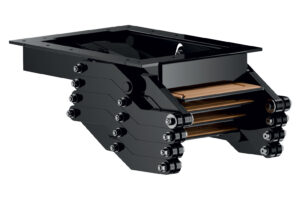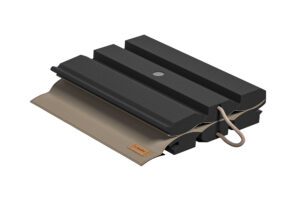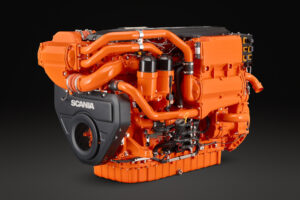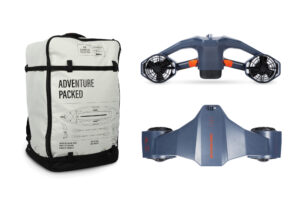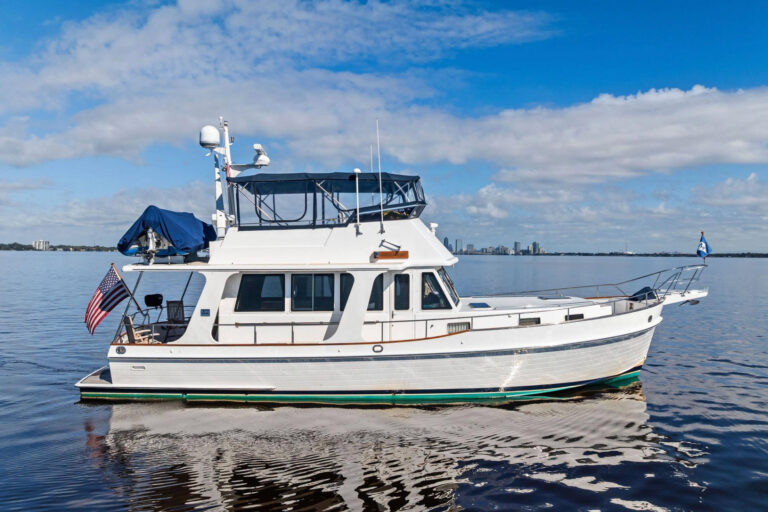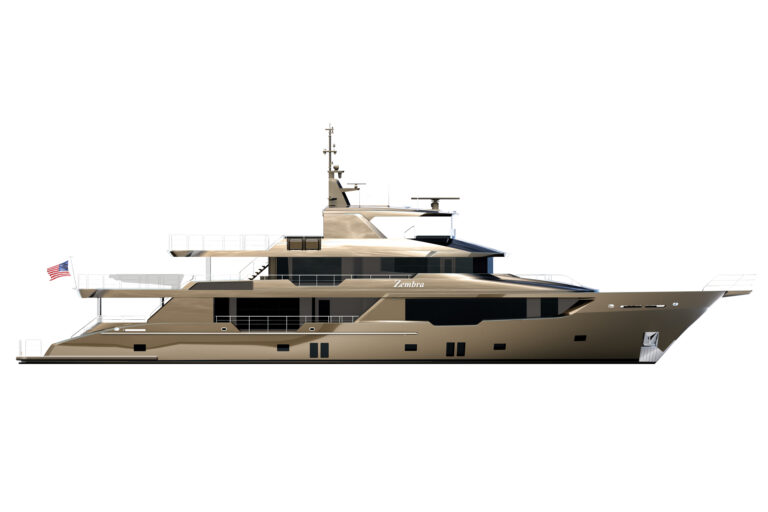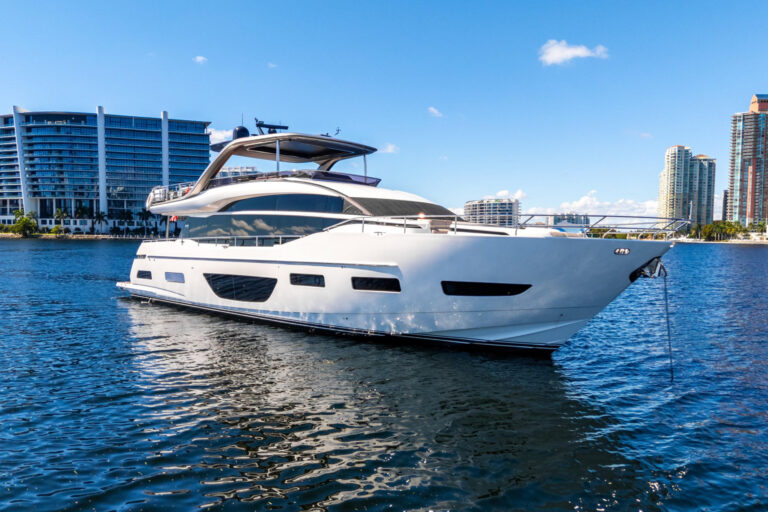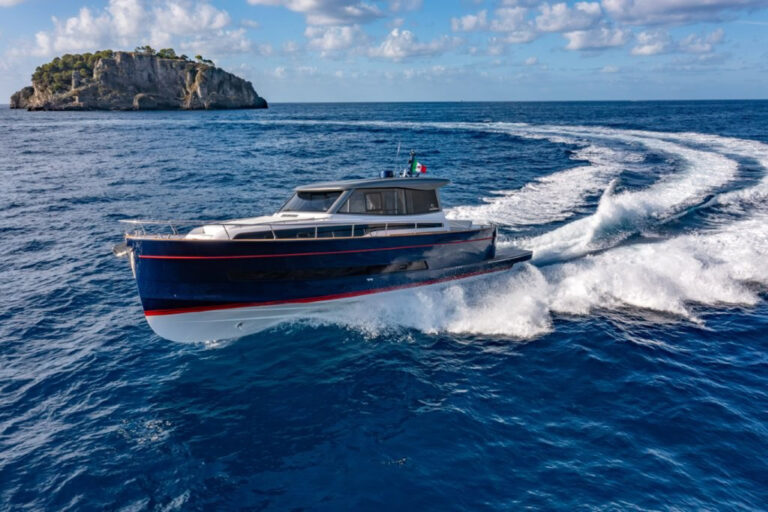
A southeasterly howled across British Columbia’s Hecate Strait as Randy Wright, president of Harbour Air, guided guests aboard a mothership to a fleet of Fat Cat fishing boats. They’d started at the resort he used to operate with his dad. When the breeze ticked past 50 knots, Wright called the anglers back. A group of Germans, however, got stuck and abandoned their vessel on Langara Island, the northernmost island of Haida Gwaii, and were soon rescued by another outfit.
The breeze abated by morning, so Wright and two hands put on survival suits and jumped into a skiff to retrieve their wayward boat. Wright dropped his mates behind a protective reef, giving them access to the stricken Fat Cat, and maneuvered to the exposed lee shore to attempt the retrieval.
“It was a mistake to be alone,” he recalled at Mustang Survival’s 50th anniversary celebration, 27 years ex post facto. “I stood with my back to the sea and tried to throw them a heaving line,” he said. No dice. Then he heard his friends’ shouts.
A glance astern confirmed his nightmare: Big waves were on the move, bearing down on him. “I gunned it to shore, surfing,” Wright said, “then my ass started to rise and the boat went end-to-end.” He dived into the frigid water and somehow surfaced, only to see a freakishly large wave barreling forth. “I survived because I was wearing a Mustang Survival suit,” Wright said, his voice cracking. “I wouldn’t have kids without that suit.”

When seas and skies grow angry, mariners such as Wright strap on life jackets, harnesses and foul-weather gear designed to make otherwise inhospitable environments conducive to survival. Building this gear properly requires years — if not decades — of hard-won experience in tough conditions. The creation process is product Darwinism: Get it right, and a business can earn survival stories such as Wright’s; get it wrong, and things go pear-shaped, fast. That’s an economic reality that takes on even greater importance when you’re in the business of keeping people alive. While less than 10 percent of all new businesses reach their 50th anniversary, Mustang Survival achieved this milestone through a companywide dedication to a six-word motto: “We save lives for a living.”
The company, with Canadian headquarters in British Columbia and U.S. headquarters in Washington State, had an inauspicious start. Irv Davies lost his job at an apparel company in 1967. Fueled by a drive to persevere and succeed, and the mock-Latin axiom illegitimi non carborundum (loosely translated: don’t let the bastards grind you down), Davies created Mustang Survival on May 29, 1967, initially offering down jackets to Alaskan fishermen. He eventually turned to hydrophobic, closed-cell foam for insulation and started making foul-weather gear.
Then, one day, Davies’ foam salesman mentioned that the insulation material Mustang Survival was using for its cold-weather jackets was the same stuff used in life jackets.
Click.

Mustang Survival began building insulated, high-flotation clothing, dubbed Floater Coats, which the company sold to mariners of all stripes. “We’ve been building on it for 50 years,” says Jason Leggatt, Mustang Survival’s vice president and general manager. The company currently earns its revenue among three categories — military and life-saving organizations, commercial fishing and recreational marine — though, regardless of where the products are sold, two of the most important words in Mustang’s lexicon are still “dry” and “float.”

By establishing early brand credibility with Alaskan fishermen and Pacific Northwest yachtsmen, Mustang Survival built a reputation for equipment that withstood the unforgiving marine environment. The company has long worked to establish strategic partnerships with leading suppliers (for example, it was an early testing partner for military-spec Gore-Tex laminates) and to stay on top of cutting-edge technologies such as fabric welding. Innovative and diversified products followed, including marine survival suits in the early 1990s, self-inflating personal flotation devices (PFDs) in 1993, G-suits for fighter pilots in 2001 and — following 1986’s Space Shuttle Challenger disaster — an enhanced flotation system for astronauts that NASA requested and used on every following shuttle mission through the program’s retirement in 2011.
“I survived because I was wearing a Mustang Survival Suit. I wouldn’t have kids without that suit.”
Randy Wright
Oscar Tsai, Mustang Survival’s plant manager in British Columbia, says one key to the company’s success is that “we practice lean manufacturing and inventory.” Workers also routinely put products to serious tests, some at the survival-suit station, where each suit is inflated to pressures well beyond the U.S. Coast Guard’s minimum standards, covered in soapy water and scrutinized for leaks. Not a single smoking-gun bubble can be seen. “It took us three years to get to this stage of manufacturing perfection,” Tsai says with pride.
Mustang Survival employs a modular approach to manufacturing. One week it might be building flotation clothing, while the next it is manufacturing PFDs. Many of the employees have been with the company for more than 20 years, Tsai says.

There’s no shortage of interesting things to keep their minds challenged. In the test lab, for instance, there’s equipment for military and first-responder teams, along with a bevy of sophisticated instruments such as a fairly rare “sweating hot plate” that tests fabric breathability. A 3D printer in this room likely foreshadows an increasing percentage of prototypes — and possibly even finished parts. I got to take a jump into the testing pool, where Cheryl So, Mustang Survival’s manager of product engineering, showed us a new line of inshore and offshore PFDs that combine passive (foam) and active (compressed air) flotation. Mustang Survival partnered with another safety-at-sea company, Hammar, to produce this line of PFDs that hydrostatically determine when they are submerged to at least 10 centimeters, the unit’s tripping point. The idea is to reduce instances of accidental inflation.
THE COMANCHE CONNECTION
When talk turns to the world’s fastest monohull, Jim Clark and Kristy Hinze’s 100-foot supermaxi, Comanche, reigns supreme. The boat set the elapsed-time record in the Newport Bermuda Race
(34 hours, 52 minutes and 53 seconds) and the coveted 24-hour distance record (618.01 nautical miles). When Mustang Survival wanted to test its EP Ocean Racing Series foul-weather gear, which uses military-spec Gore-Tex fabrics, aboard an outrageous sailing platform, it reached out to Canadian Richard Clarke, a five-time Olympian, for suggestions. Clarke sails aboard Comanche, and the team has been helping to develop the garments ever since.
I zipped up a Mustang Survival Sentinel Series dry suit, adjusted its new Khimera hybrid PFD and leaped into the 12-foot pool. The PFD ensured a shallow plunge, and, after surfacing, I yanked the vest’s inflation handle. The PFD swelled, creating several additional inches of freeboard, but unlike traditional inflatable PFDs that fully expose their U-shaped bladders, the Khimera remained more form-fitting. Mustang Survival’s now-generation vests use proprietary Membrane Inflatable Technology, which buries the bladder under a sewn restraint to achieve the fit. I rotated through several more vests, all far less jolting upon inflation than the Type V Mustang Survival PFD that I’ve owned for 15-plus years.
Four hours later, I listened to Randy Wright’s voice well up with emotion as he described — in front of some of the very employees who built his survival suit — the debt of gratitude he owed to his Mustang Survival equipment.
Irv Davies’ original, deep-down drive to succeed didn’t just result in a profitable business for Mustang Survival. It’s yielded countless life-changing, nay, life-saving outcomes.

